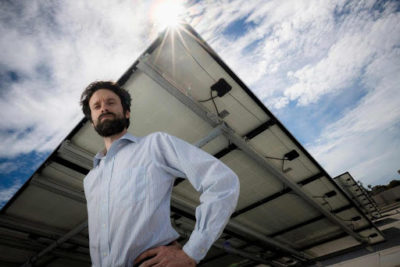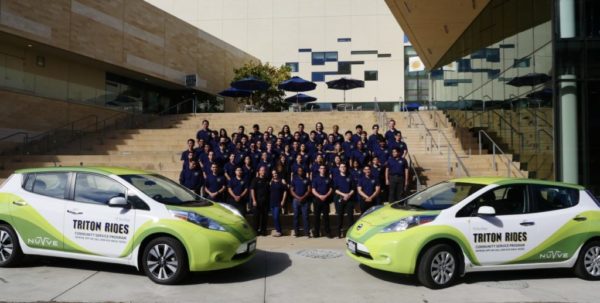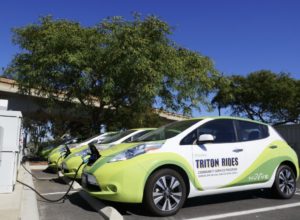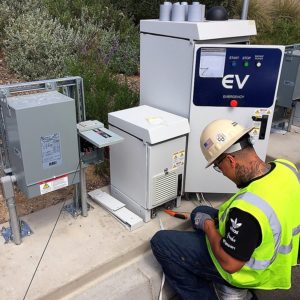
Vehicle-To-Grid (V2G) Innovation Balances the Grid at UC San Diego
February 4, 2021
Nuvve’s patented vehicle-to-grid (V2G) technology optimizes electric vehicle (EV) charging, lowering the total cost of ownership for EVs, and increasing the positive environmental impact of EVs by supporting the introduction of renewable energy sources, with UC San Diego serving as one of their site hosts for their pioneering technology.
A true Lab to Market success story, the partnership was a result of a California Energy Commission-funded collaboration between UC San Diego’s Center for Energy Research (CER) and Facilities Management - serving as the site host for a variety of V2G EV chargers on and off campus, becoming the first (and only) V2G interconnection with SDG&E’s distribution circuit.
Principal Investigator and Director of CER Jan Kleissl and Byron Washom, UC San Diego's first director of Strategic Energy Initiatives, share their entrepreneurial journey making ‘Vehicle-to-Grid’ a reality on campus.
What has been your experience with UC San Diego and its diverse entrepreneurial culture?
 BW: UC San Diego has a unique set of circumstances that make it the perfect site host, in addition to the CalTestBed voucher program to assist clean energy entrepreneurs. We have a robust microgrid which is self-regulated, we do our own permitting, we prepare our own environmental impact statements plus we have our own California fire marshal.
BW: UC San Diego has a unique set of circumstances that make it the perfect site host, in addition to the CalTestBed voucher program to assist clean energy entrepreneurs. We have a robust microgrid which is self-regulated, we do our own permitting, we prepare our own environmental impact statements plus we have our own California fire marshal.
We were able to accelerate time of demonstration, as compared to off campus sites located within a utility’s governance; thus, we are a natural accelerant to commercialization. We also have a research mentality - we understand setbacks and recognize they create opportunity for improvement.
I’d like to say that at UC San Diego, we roll out the red carpet and shampoo it everyday. This is part of our entrepreneurial spirit. Deepening and broadening the commercial penetration of technology is in our creed.
What excites you about your work?
JK: With V2G technology, you can use the energy in the battery for many services. You can feed energy back to the grid or potentially power your home during an outage. The technology is truly pioneering. Electrifying transportation and making it more compatible with the solar powered grid is a huge but important task.
Additionally, energy startups often struggle with complex engineering challenges associated with optimizing their resources and with crunching data. Working with my students on real world innovation and industry projects allows them to put their research into practice. It’s very rewarding.
Describe a typical day in Startupland. What does your day look like?
 BW: All innovators come to us and say it's ‘plug and play’ - but we really say 'plug and pray,’ turning their prayers into reality. Campus Associate Engineer Kevin Norris is a very essential part of our program, instrumental on every renewable and EV storage project. The level of sophistication and interaction of faculty, researchers, and facilities management on campus is very unique and critical to our success.
BW: All innovators come to us and say it's ‘plug and play’ - but we really say 'plug and pray,’ turning their prayers into reality. Campus Associate Engineer Kevin Norris is a very essential part of our program, instrumental on every renewable and EV storage project. The level of sophistication and interaction of faculty, researchers, and facilities management on campus is very unique and critical to our success.
JK: When putting prototypes on a grid, there are myriads of issues that arise. We need the time and money to show the facts about the technology that convince investors, clients, and policy makers that it is safe, functioning and ultimately beneficial. We assist with performance improvements and optimization suggestions. Our students are critical in fine tuning operation, data analysis, and optimization.
How do you define innovation in the 21st Century?
BW: For me, it is a formal process, otherwise known as the technology readiness level (measured from 1-9). Nine is early commercial and needs slight improvement whereas a two is basic research. Most of our work lands in the four to seven range. Nuvve was a five when they arrived and are now a 8.5 on the verge of becoming a publicly traded company. It’s incredibly exciting.
JK: For me, excitement comes when you test innovation in the real world. How does it help if we can't use it on campus? The refinement aspect makes me the most excited, that transition to a product.
What role have mentors played in your success/journey?
 JK: I met Byron early on at a UCSD sustainability awards ceremony and he truly helped bridge the world of innovation with research. I would have never been able to convince Nuvve to apply for the California Energy Commission contract without him. He opened the doors and allowed us to create an exciting research project.
JK: I met Byron early on at a UCSD sustainability awards ceremony and he truly helped bridge the world of innovation with research. I would have never been able to convince Nuvve to apply for the California Energy Commission contract without him. He opened the doors and allowed us to create an exciting research project.
BW: My most significant mentor as an entrepreneur was Jerome Katzin dating back to 1980, who coincidentally at that time was becoming a pillar of growth for UC San Diego innovation. He served for three decades as a member of UC San Diego Foundation and a significant player in campus development.
What are some of the biggest challenges you faced in the startup process? How were you able to overcome them?
 BW: We enjoy being an incubator, sometimes we joke that we are a prenatal care incubator. An entrepreneur is usually extremely welded to the technology and approach from their ‘sweat equity’ cycle. They aren't always receptive to suggestions to improve and need an extra amount of attention and engagement.
BW: We enjoy being an incubator, sometimes we joke that we are a prenatal care incubator. An entrepreneur is usually extremely welded to the technology and approach from their ‘sweat equity’ cycle. They aren't always receptive to suggestions to improve and need an extra amount of attention and engagement.
It takes some delicate diplomacy of how to expose them to alternatives or improvements that they might wish to incorporate. I call it a bedside manner, working with entrepreneurs who are almost overly dedicated to their technology.
What advice would you give to a UC San Diego student thinking about starting a company?
JK: Intern for a company. Seeing the outside world is invaluable to learning about innovation. Work with someone like Byron, someone who has the vision for how we can make campus operations more efficient and sustainable.
BW: Look at the future market. One of President Biden’s first executive orders was to put 40% of all clean energy federal investments into disadvantaged communities. We cannot just focus on the technologies in the lucrative marketplace but also how they can serve those that are disadvantaged. Low income and underserved communities have not been targeted in most entrepreneur’s commercialization plans.
They suffer the highest exposure to local pollutants. There is an old hockey adage - skate to where the puck is going to be rather than where it is. My Wayne Gretzky guidance to students and entrepreneurs is that you need the ability to understand the market with regards to the space of sustainability. This is where the puck is going to go during their career.
To learn more about how to integrate renewable energy resources into the power grid, please contact jkleissl@ucsd.edu and visit UC San Diego’s DERConnect.